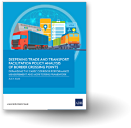How can the TPP without the US still make sense?
Since the withdrawal of the United States from the 12-country Trans-Pacific Partnership (TPP) early this year, the once promising mega trade deal has lost momentum. However, the agreement is gaining renewed attention, with the remaining 11 members pushing to conclude TPP 11, under its new title—the Comprehensive and Progressive Agreement for Trans-Pacific Partnership.
What’s the motivation behind this move, and what are the costs and benefits?
First, the US withdrawal is undeniably a setback to the potential scale of economic benefits. With the US, total exports of the 12 members would have accounted for 26.6% of world trade, of which 11.4% would have come from trade among the members themselves.
With 11 members, their world trade share falls to 15.2% and intraregional share to mere 2.3%, respectively. This is due to the US being the largest trade player among the original 12 TPP countries, representing 11.4% of world trade and 41% of trade among members.
But the revived deal retains significant potential for gains for its 11 members, though the impacts will vary across different countries.
Revived TPP retains significant potential for economic gains for its 11 members
After the US, Canada was the second largest in terms of the intraregional trade (trade among TPP members) share at 16.2%. In a TPP 11 scenario, the country’s intraregional trade share plunges to only 9%, which significantly drives down Canada’s economic benefit from lower tariff and other trade barriers from the deal relative to others.
Japan’s intraregional trade share, on the other hand, jumps to 24% from 10.4%. This partly explains why Japan has a keen interest in sustaining TPP 11, as do Australia, Malaysia and Singapore, whose intraregional trade share also increases in an agreement without the US.
The devil, though, is in the details.
The 10 member states of the Association of Southeast Asian Nations (ASEAN) have free trade agreements (FTAs) among themselves and with Japan, while Canada has no FTAs with any Asian countries in the TPP 11. Also, Japan, Malaysia, and Singapore are Canada’s important trade partners in terms of trade volume. In this sense, Canada can still expect significant gains from TPP 11 by cultivating broad opportunities of preferential treatments provided by Asian trade partners.
Economic gains
One way to gauge the potential impact of a regional trade deal is to examine the wedge (ratio) between each country’s intraregional trade share and its share of total world trade.
If the former is much greater than the latter, the country has relative bias toward intraregional trade. This can bring about larger economic gains due to lower trade barriers from the trade deal. It can also entail smaller trade diversion effect – a sort of distortion by diverting efficient goods and services transactions with non-member countries toward less efficient transactions with member countries to avail of preferential treatment, causing negative welfare impact to non-member countries and inefficiencies in resource allocations.
Overall, the average ratio declines from 0.42 under TPP 12 to 0.21 under TPP 11, implying smaller potential gains from lower trade barriers and higher possibility of trade diversion effects to incur to non-members at the same time. At the country level, Canada and Mexico show the highest ratio at 0.72 and 0.71 respectively under TPP 12, while Brunei Darussalam, New Zealand, and Malaysia lead under TPP 11.
Numbers aside, TPP 11 is expected to ensure much larger economic gains to members due to further liberalization of investment flows, facilitation of cross-border e-commerce transactions, and better protection of intellectual property rights among others.
Particularly worth noting is the introduction of cumulative rules of origin, by which member countries will be able to flexibly use inputs across different member countries to obtain preferential tariff treatment from other members. This will promote strong regional value chains among member countries, which is difficult to expect from typical bilateral trade deals.
Flip side of TPP benefits is lost opportunity for US by pulling out
The flip side of these benefits is the lost opportunity for the US by pulling out of the deal. In addition, Asian TPP members that don’t have FTAs with either the US and Canada will have more incentive to invest in Canada to manufacture products there and export them to the US in order to gain from the preferential treatment offered by the North America Free Trade Agreement to Canadian exports to the US.
So, while tariff gains for Canada and Mexico could be much smaller under TPP 11, these countries may become a stronger foothold for investors from Asian TPP members.
The remaining 11 countries still have good reason to maintain the TPP momentum in one way or another, as shown by the ongoing push to finalize the deal. Certainly, this is the right direction at the right time, with global growth still struggling to gain traction. Furthermore, the pact’s members should proactively consider expanding the scope to encompass additional members who are willing to commit to similar obligations.
By expanding the scope of economies covered instead of standing as an exclusive trade bloc, the new trade deal would amplify the mutual benefits among members while minimizing negative economic fallout for the rest of the world.
Original article was published at the ADB Blog and duplicated here with permission from the author. *




